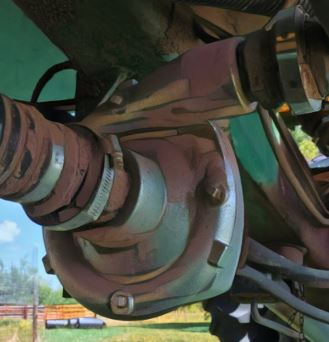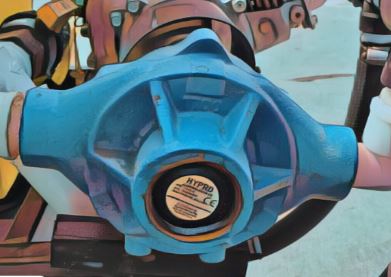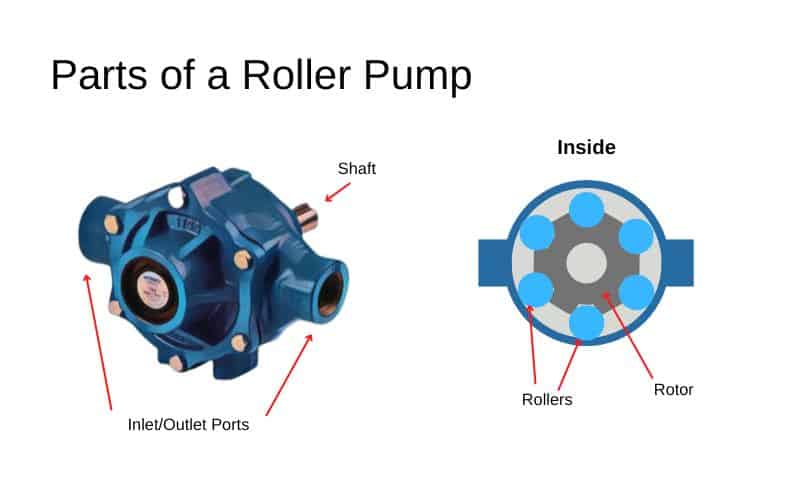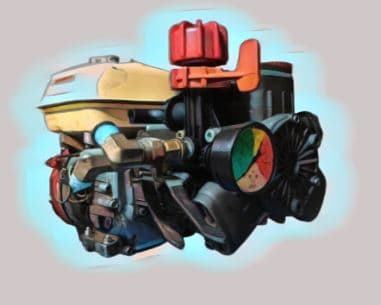Pumps are the centerpiece of any sprayer. Sprayer nozzles may be the most important part but a sprayer will not be effective without the proper pump for the job. There are several different types of sprayer pumps. The huge number of variations is a result of the wide range of different methods used to apply pesticides, fertilizers, liquid deicers, cleaning products, etc.
Can I Use Any Pump for a Sprayer?
The simple answer is no. Pumps vary in volume, pressure, horsepower requirements, materials, and more. The wrong pump could result in poor performance, potential damage to your sprayer, or even personal harm
What Type of Pump is Best for a Sprayer?
No one pump is best for a sprayer. The needs of each application will need to be considered to know what is the best pump type. There may be several different types or styles of pumps that work fine. Sometimes the “best” option is quite expensive and a lower-cost option will suit your needs just fine.
Some applications require low flow while others require high flow, and some applications will require very high pressure. Different types of pumps are needed to accomplish these spraying tasks. Selecting the right pump can be a challenge especially when there are budgetary constraints to consider. In this article, we will discuss the various types of sprayer pumps, common applications, and how to identify what pump is right for your sprayer.
Related: How to Size a Pump for a Sprayer
Centrifugal Sprayer Pumps
All pumps can be put into two main categories: centrifugal pumps and positive displacement pumps.

Centrifugal pumps use centrifugal force to create suction and move liquid. Centrifugal pumps are known for their ability to move high volumes of liquid. One key attribute of a centrifugal pump is that it will only develop a certain amount of pressure. If the pump outlet is closed and the pump is still running the pressure in the discharge line can only reach a certain amount. This maximum pressure will vary depending on the pump design, impeller diameter, rpm, and more.
The performance of a Centrifugal pump is expressed in a pump curve. A pump curve is shown in a graph that displays a centrifugal pump’s flow rate at different operating points. This information will help you when deciding if a pump is capable of meeting the demands of your application.
What Types of Sprayers Use Centrifugal Pumps?
Centrifugal pumps are used in countless ways throughout our world. When it comes to sprayers they are used when the application requires high flow rates that other types of pumps cannot produce. They are commonly used on agriculture sprayers, deice sprayers, and large turf sprayers.
- Agriculture: Both pull-type and self-propelled crop sprayers rely on centrifugal pumps. They provide the flow needed for large booms that cover 40, 60, 80, or even 120 feet swaths with several nozzles.
- De-ice: Preventing ice build-up on roads requires a fairly high volume of liquid. It is also applied at higher speeds relative to other types of spraying. This requires centrifugal pumps that can keep up with the application rates for de/anti-icing.
- Dust Control: Another application where high volume is crucial. A centrifugal pump is needed to supply enough water
How Does a Centrifugal Sprayer Pump Work?
As stated earlier centrifugal pumps move liquid via centrifugal force. The main components of a centrifugal pump are the housing, the impeller, the shaft, and the shaft seal. The impeller is mounted on the shaft and as a motor or engine spins the shaft rotates the impeller. Liquid inside the pump is forced out away from the center of the impeller against the pump case and out the outlet of the pump. The center of the impeller is called the eye of the impeller. The result of liquid being forced out of the eye of the impeller is low atmospheric pressure. This low atmospheric pressure creates suction drawing liquid into the inlet of the pump.
Parts of a Centrifugal Sprayer Pump
- Impeller: The impeller is a rotating component that is driven by a motor or engine, it converts the rotational energy into flow energy
- Volute: The volute is a casing that surrounds the impeller, it collects and directs the water flow from the impeller.
- Shaft: The shaft connects the impeller to the motor or engine, allowing them to rotate together.
- Seal: The seal is used to prevent leakage between the rotating shaft and the stationary pump body
- Inlet and outlet ports: These are the ports where the liquid enters and exits the pump.

Centrifugal pumps are relatively simple but when they do not perform the cause can seem like a mystery. If you are new to centrifugal pumps be sure to read this article to see a full troubleshooting guide.
Different Types of Centrifugal Sprayer Pumps
There are two main families of centrifugal pumps: straight and self-priming. There are several variations within these two families. They vary in performance, design, and materials of construction.
Self-priming Pumps
A self-priming centrifugal pump is able to pull liquid from a location that is below the level of the pump inlet. This is achieved via a combination of volute design and suction created by the pump. Self-priming pumps are designed to keep liquid in the volute when the pump is not running. This allows them to maintain prime after each use.
Self-priming pumps are often used as transfer pumps to load and unload sprayers or nurse tanks. They provide more flexibility to the user in this scenario because they do not have to be installed lower than the tank outlet. This means they can be installed on a truck or trailer and lift water from a source on the ground.
Straight Centrifugal Pumps
A straight centrifugal pump will also create suction the same way that a self-priming pump does, however, due to the design of the pump volute, they do not trap liquid and maintain a prime. The inlet of the pump must be gravity fed so that the pump is not operated without liquid. Straight centrifugal pumps are generally more efficient than self-priming pumps.
Straight centrifugal pumps are more common on large boom sprayers. They can achieve the higher pressures that may be required by a broadcast sprayer. Typically, a sprayer pump is not going to be moved around and used for different jobs, so it can be permanently installed below the tank where a self-priming pump is not necessary.
Different Drive Types for Centrifugal Sprayer Pumps
A centrifugal pump can be driven by any means that provides adequate horsepower and rpm. When used onboard sprayers these are the common drive types:
- Belt drive – A centrifugal pump can be equipped with a pulley on its shaft and driven by a power source via a belt. The power source could be the engine of a vehicle, eclectic motor, hydraulic motor, etc. Often an electric clutch is used to engage a pump when operated by the engine of a vehicle.
- Hydraulic drive – Hydraulic drive is an extremely common type of centrifugal pump on agriculture sprayers.
- Engine-driven – Gas or diesel engine-driven centrifugal pumps are very common. They are often called “trash” pumps or transfer pumps and usually, the pump is self-priming. This kind of pump can be used on skid-mounted sprayers where a hydraulic or electronic power source is not available.
- Electric motor – Centrifugal pumps that are electric motor driven are generally not used onboard a sprayer. The voltage required is not available on vehicles, trucks, or tractors. They are instead used as stationary transfer pumps.
- PTO – This is a common drive type when spraying with a tractor or other piece of equipment with a PTO. Typical PTO pumps will have a gearbox or be belt driven because the pump will require higher RPM than the PTO spins.
Positive Displacement Sprayer Pumps
Positive displacement pumps move fluid via some sort of mechanical action. In other words, the liquid is physically being pushed or squeezed out. There are several means to achieve this, moving pistons, flexing diaphragms, rotating gears, etc.
As the pump runs, it draws in batches of fluid with each stroke, rotation, or another mechanical movement, and then forces it out of the pump. Positive displacement pumps are capable of achieving higher pressures than centrifugal pumps, and they are used to handle more viscous liquids, such as fertilizers or oils. Because of the nature of a positive displacement pump, they require pressure relief valves to release excess pressure and prevent damage to the sprayer or pump itself.
Positive displacement pump types:
- Roller pump
- Diaphragm pump
- Piston pump
- Gear pump
- Squeeze pump
12-Volt Diaphragm Pump

12 V diaphragm pump is an extremely common pump. They are relatively inexpensive and can be made from materials that hold up to a wide variety of chemicals. Because they are small and powered by small motors they are very mobile. 12-volt diaphragm pumps are versatile pumps used in many different industries.
12-Volt Pump Uses
They are an extremely common pump type used on small boom sprayers, ATV/UTV sprayers, and spot sprayers. They can handle viscous liquids like fertilizers and even oils As long as they are constructed with materials compatible with petroleum products. Because these pumps only require a 12-volt power source (hence the name), they are ideally suited for use with ATVs on ours basically any other piece of equipment that has a 12-volt battery on it.
They are not only used as sprayer pumps. You will see them used in RVs, soft wash systems, coolant pumps, and more.
- ATV Sprayers
- Spot Sprayers
- Lawn Sprayers
- RV fresh water pump
- Waste oil removal
- Commercial cleaning/rinsing
- RO water systems
Parts of a 12 Volt Sprayer Pump

- Diaphragm Assembly: Flexible membrane that “wobbles” as turned
- Valve Assembly: Opened and closed by the action of the wobble plate, moving liquid
- Motor: This is the power source that drives the pump
- Housing: The pump cover/casing, the inlet and outlet ports
- Pressure switch: Some diaphragm pumps have a pressure switch that turns the pump on and off depending on the pressure in the system.
How a 12-Volt Sprayer Pump Works
As you can see these pumps do not have many components, however, they are intricately designed to operate effectively. The two main internal assemblies (the valve assembly and the diaphragm assemble) work together in order to create the vacuum that draws in liquid and the pressure to force it out. This is achieved because the design o the diaphragm assembly is eccentric so it “wobbles” as the motor spins. This alternately pushes one diaphragm into a check valve chamber and then back out. When it is pushed into the chamber it forces liquid out of the exhaust port of the check valve assembly. When the diaphragm leaves the check valve chamber it creates a vacuum that opens the check valve and draws in more liquid. This happens very rapidly resulting in a consistent flow and pressure on the discharge side of the pump.
12-volt pumps can be repaired and often the fix is simple. You can see a full guide to help beginners troubleshoot 12-volt pump issues in this article.
Different types of 12-Volt diaphragm pumps
When it comes to sprayers there are basically two main types of 12-volt diaphragm pumps used, demand and bypass. The difference between these two is covered in great detail in this article on why these pumps surge, but essentially demand pump has a pressure switch that will shut the pump off when a set pressure is reached. A bypass pump does not.
The demand style is most often used on spot sprayers and small lawn sprayers where the operator is using a spray wand or trigger gun. When you are not pulling the trigger, the motor does not run. This happens because your handgun is closed causing the pressure in the line to increase to the point where it trips the pressure switch in the pump. This is ideal for these types of sprayers so that your pump is not constantly running and draining the battery, but they also work on other sprayers as well.
Within these two 12-volt pump types, there are many varieties available. They differ in the maximum flow rate, the max pressure they can produce, as well as the materials used to make them. A 12-volt sprayer pump will typically produce 1-5 gallons per minute flow and 40-60 psi. There are specialized models that are capable of producing more flow or PSI but these are typically used for other non-spraying applications.
READ MORE: 12-Volt Diaphragm Pump Guide
Roller Pumps

A roller pump is another type of positive displacement pump commonly used on agriculture, turf, and garden sprayers. As with 12-volt diaphragm pumps there are several different models available. These different models vary in the flow rate and pressure they can produce as well as the materials used to construct them.
There is a range of different-sized roller pumps on the market. The smallest produces 8 GPM at 50 psi to larger pumps can produce about 40 GPM at 200 psi. They are commonly constructed of cast iron housings, stainless steel shafts, Viton seals, and poly/nylon rollers. You can order models that are made of special materials that are more resistant to many fertilizers, agrochemicals, and pesticides.
Roller Pump Uses
Roller pumps fill a need in agriculture, turf management, and pest control that a 12-volt diaphragm pump can’t provide. They produce higher flow and can also deliver the pressure needed to push fluid through long lengths of hose. Although small roller pumps can be driven by 12-volt motors, typically they are driven by a PTO or gas engine.
How Does a Roller Pump Work?

A roller pump works by using a small metal drum known as a rotor, along with several plastic cylinders called rollers to move liquid through the pump. The rotor is mounted on the pump shaft that extends out of the housing. This is connected and driven by an external power source. Usually a PTO or a gasoline engine.
The rotor has slots for the rollers and as it turns it carries the rollers along the outer edge of the pump housing. There is some clearance between the bottom of the pump housing and the rotor, when the roller reaches the bottom, gravity acts on the roller and it pushes the liquid that is entering the pump along.
Different Types of Roller Pumps
As mentioned earlier there are several different sizes of roller pumps that are available. They vary in not only flow rate but the number of rollers inside and the pressure that they can produce. There are also different material options. Most manufacturers of roller pumps provide stainless steel options. Hypro, one of the largest roller makers, offers a Silvercast pump that is more resistant to fertilizers and chemicals, specifically round-up/glyphosate. There are also different rollers available. Rollers can be made of nylon polypropylene or Teflon.
One point to keep in mind for roller pumps is the RPM at which these pumps can be driven may vary from model to model. Many roller pumps are designed to be used by a PTO, usually, 540/1000 rpm. Others are made to be driven by gas engines usually turning much more than 1000 RPM. The direction of the shaft rotation will also vary. PTO pumps are driven counterclockwise and an engine drive pump is clockwise.
Medium/High-Pressure Diaphragm Pumps

Applications such as tree spraying need some serious “throw” or distance out of your spray gun. To spray 50-plus feet other pump types won’t cut it. You need a high-pressure diaphragm pump. Compared to centrifugal pumps and roller pumps, diaphragm pumps are “high” pressure with models that produce from about 250 psi to 800 psi. Many people refer to them as “medium” pressure pumps because there are other pumps, like pressure washer pumps, that produce more pressure.
This is why even though they produce higher pressure than other fun times they’re considered “medium pressure“ pumps. They are the perfect type of pump for tree sprayers because they produce the pressure and flow needed to create a stream of liquid that can reach the heights of tall trees. Plus, the resilient diagrams can work with chemicals used in these applications. A diaphragm pump along with the proper tree spray gun is needed to achieve spray heights 50 feet and higher.
Diaphragm Pump Uses
High-pressure diaphragm pumps have a wide range of applications beyond just tree spraying. Diaphragm pumps are often used in the following applications:
- Agriculture: Used for crop spraying, weed control, and fertilization applications where centrifugal pumps won’t produce the required pressure with viscous fertilizers and agrochemicals.
- Turf care: The versatility of the pump makes it great for, sports fields, golf courses, and landscaping. You can spray far or use it on a boom sprayer.
- Cleaning: Although they don’t produce the same psi as the plunger pumps used on pressure washers, they can provide more flow that is useful when cleaning out debris like mud or other waste, and it is less prone to splatter or cause damage than a standard pressure washer.
- Firefighting: Small spray rigs that are made to fight brush/range fires use diaphragm pumps because they can reach small fires from safe distances and supply plenty of flow.
How Does a Diaphragm Pump Work
Like the rest of the positive displacement pumps, diaphragm pumps get their name from the method they use to “pump” liquid. The pump is driven by an engine or motor that spins its crankshaft. The shaft is connected to a set of pistons and a diaphragm is attached to the end of each piston.
Similar to a car engine, as the crankshaft turns it moves each piston. The movement of each piston up and down inside the pump draws liquid in and pushes it out. This action creates a continuous flow that is then directed by the manifold and sprayer controls. The crankcase is filled with oil to keep the pistons lubricated. The diaphragm provides a seal between the crankcase and the fluid that is being transferred. The flexibility and chemical resistance of the diaphragm is key to making all of this function properly.
Different Types of Diaphragm Pumps
Most pump types have several different variations available, and diaphragm pumps are no different. They vary in drive type, flow rate, max pressure, number of pistons/diaphragms, materials, shaft configurations, etc.
Drive Types:
- Gas engine:
- Hydraulic
- PTO
Housing Materials:
- Poly
- Aluminum
- Stainless Steel
Diaphragm Materials:
- Desmopan
- Blueflex
- Buna
- Viton
Diaphragm Pump Flow Rate & Pressure Range:
- Different models range from about 200 PSI to 750 PSI
- Flow rates vary from 3 to 100 gallons per minute
There are many factors that affect spray distance, but in general, if you need to spray 40-50 foot tall trees you will need a pump that can produce at least 10 GPM and 500 psi. For trees up to 60 ft, you need a pump that can give you more than 20 GPM and 500 or more PSI. Below is an example of a pump that would provide the required flow and pressure to spray 50-foot-tall trees when paired with an engine that delivers adequate horsepower.
Pump to Spray 40-50 Foot Trees: Udor Kappa 55

Spraying tall trees does require more than just the right pump. If you want to know all the components needed to spray trees be sure to read my post about spraying tall trees. You can also find information on troubleshooting and repairing a diaphragm pump in this article.
Piston Pumps
A piston-type pump is a type of sprayer pump that is used in pest control and orchard spraying. Piston pumps are well-suited to these applications because they can handle a wide range of chemical solutions and they produce the flow and pressure needed to propel fluid high enough to reach the branches in trees. There are different sizes available but generally, they will produce 5-20 GPM and 500+ psi. They are typically more expensive than their diaphragm counterparts which can develop similar pressure and flow rates. This is due to their longer life expectancy and efficiency.
Piston Pump Uses
Piston pumps are commonly used in a variety of applications:
- Agriculture: Piston pumps are used in agricultural spraying applications. Often used as fertilizer metering pumps. They are also commonly used in orchards and vineyards.
- Turf and lawn care: Golf courses, sports fields, and residential lawns.
- Pest control: Piston pumps are used to apply pesticides in and around buildings, such as for termite control, bed bug eradication, and mosquito abatement.
- Forestry: Piston pumps are used in forestry and land management to apply pesticide treatment for the protection of trees from pests and disease and for the control of invasive species.
How Do Piston Pumps Work?
A piston pump is in the positive displacement pump family. It uses reciprocating pistons to move fluid through a cylinder or chamber. The piston is typically driven by a rotating crankshaft. The crankshaft can be driven by almost any motor type: hydraulic, electric, gas-engine, etc.
As the piston is moved back and forth in the cylinder, it draws fluid through an inlet valve and then pushes it out through an outlet valve. This motion generates the flow of fluid in one direction. The flow rate is determined by the speed of the piston and the size of the pump’s cylinder.
Parts of a Piston Pump
While there can be variations, these are the basic components of a piston pump:
- Inlet valve: Allows fluid to enter the pump, and prevents fluid from flowing back out when it is closed.
- Outlet valve: Allows fluid to exit the pump through the outlet port when open, and prevents fluid from flowing back in when closed.
- Piston or plunger: The piston or plunger is the cylindrical component that moves back and forth within the pump cylinder. It creates pressure that moves the fluid through the pump.
- Cylinder: The cylinder is where the piston or plunger moves up and down, moving the fluid.
- Seals: Prevents fluid from leaking out and reduces the loss of pressure.
- Inlet and outlet ports: These ports allow fluid to enter and exit the pump, and are connected to the inlet and outlet plumbing on the sprayer.
- Drive: The mechanism that provides the power to turn the driveshaft. Typically through a motor or engine that is connected to the pump.
The specific design and construction can vary depending on the intended use, the manufacturer, and other factors.
Summary
Sprayer pumps are a vital part of a sprayer. They play an important role in providing the required flow for a sprayer to work effectively. Different types of pumps are available to meet different spraying needs. They vary in the type of materials, configurations, flow rates, and pressure. Understanding the differences between pumps can help you choose the right one for your application, and ensure effective and efficient application.
